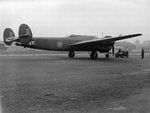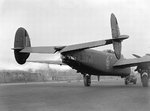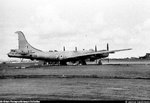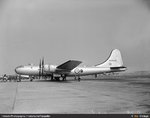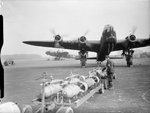- Thread starter
- #101
Navigation
Install the app
How to install the app on iOS
Follow along with the video below to see how to install our site as a web app on your home screen.
Note: This feature may not be available in some browsers.
More options
You are using an out of date browser. It may not display this or other websites correctly.
You should upgrade or use an alternative browser.
You should upgrade or use an alternative browser.
British Bombers and Transport aircrafts
- Thread starter gekho
- Start date
Ad: This forum contains affiliate links to products on Amazon and eBay. More information in Terms and rules
More options
Who Replied?- Thread starter
- #102
The first squadron to operate the Albemarle was No. 295 at RAF Harwell in January 1943. Other squadrons to be equipped with the Albemarle were No. 296, No. 297 and No. 570. Other RAF squadrons operated small numbers of the aircraft. Albemarles took part in many of the major British airborne operations such as the invasions of Sicily and Normandy and the assault on Arnhem during Operation Market Garden. In October 1942, the Soviet Air Force placed a contract for delivery of 200 Albemarles. No 305 Ferry Training Unit was set up at RAF Errol near Dundee to train Soviet aircrews. During training, one aircraft was lost with no survivors. The first Albemarle from Scotland flew successfully to Vnukovo airfield on 3 March 1943, followed by 11 more. Two aircraft were lost over the North Sea (one to German interceptors, one unaccounted for).
Tests of the surviving Albemarles revealed their weaknesses as transports (notably the cramped interior) and numerous technical flaws; in May 1943, the Soviet government put further deliveries on hold and eventually cancelled them in favor of abundant American C-47 Skytrains. The Soviet camp at Errol field continued until April 1944, apparently the Soviet command hoped to secure de Havilland Mosquito deliveries. Twelve Soviet Albemarles served for about two years; at least two were lost in accidents. Surviving aircraft were retired at the end of 1945.
Tests of the surviving Albemarles revealed their weaknesses as transports (notably the cramped interior) and numerous technical flaws; in May 1943, the Soviet government put further deliveries on hold and eventually cancelled them in favor of abundant American C-47 Skytrains. The Soviet camp at Errol field continued until April 1944, apparently the Soviet command hoped to secure de Havilland Mosquito deliveries. Twelve Soviet Albemarles served for about two years; at least two were lost in accidents. Surviving aircraft were retired at the end of 1945.
Attachments
vikingBerserker
Lieutenant General
Great posts, it might not have been much but I do like the looks of the Albemarle.
Good stuff!
- Thread starter
- #105
Postwar, several Royal Air Force Bomber Command squadrons were equipped with B-29s loaned from USAF stocks. The aircraft were known as the Washington B.1 in RAF service , and remained in service from March 1950 until the last were returned in early 1954, having been replaced by initial deliveries of the UKs 'V-bomber' aircraft.
Attachments
- Thread starter
- #106
The Hendon was built to meet the Air Ministry Specification B.19/27 for a twin-engine night bomber to replace the Vickers Virginia, competing against the Handley Page Heyford and Vickers Type 150. The specification required a range of 920 mi (1,480 km) at a speed of 115 mph (185 km/h), with a bombload of 1,500 lb (680 kg). To meet this requirement, Fairey designed a low-winged cantilever monoplane with a fixed tailwheel undercarriage. The fuselage had a steel tube structure with fabric covering and housed the crew of five, consisting of a pilot, a radio operator/navigator, and three gunners, manning open nose, dorsal and tail positions. Bombs were carried in a bomb-bay in the centre-fuselage. Variants powered by either radial engines or liquid cooled V12 engines were proposed.
The prototype K1695 (which was known as the Fairey Night Bomber until 1934) first flew on 25 November 1930, and was powered by two 460 hp (340 kW) Bristol Jupiter VIII radial engines. The prototype crashed and was heavily damaged in March 1931, and so was re-built with two Rolls-Royce Kestrel engines replacing the Jupiters. After trials, 14 production examples, now named the Hendon Mk.II were ordered. These were built by Fairey's Stockport factory in late 1936 and early 1937 and flown from Manchester's Barton Aerodrome. Orders for a further 60 Hendons were canceled in 1936, as the prototype of the first of the next generation of British heavy bombers - the Armstrong Whitworth Whitley - had flown, and it showed much higher performance. The Hendon Mk.II was powered by two Rolls-Royce Kestrel VI engines. It had a fixed undercarriage and a crew of five while the production Hendon Mk.II included an enclosed cockpit for the pilot and navigator
The prototype K1695 (which was known as the Fairey Night Bomber until 1934) first flew on 25 November 1930, and was powered by two 460 hp (340 kW) Bristol Jupiter VIII radial engines. The prototype crashed and was heavily damaged in March 1931, and so was re-built with two Rolls-Royce Kestrel engines replacing the Jupiters. After trials, 14 production examples, now named the Hendon Mk.II were ordered. These were built by Fairey's Stockport factory in late 1936 and early 1937 and flown from Manchester's Barton Aerodrome. Orders for a further 60 Hendons were canceled in 1936, as the prototype of the first of the next generation of British heavy bombers - the Armstrong Whitworth Whitley - had flown, and it showed much higher performance. The Hendon Mk.II was powered by two Rolls-Royce Kestrel VI engines. It had a fixed undercarriage and a crew of five while the production Hendon Mk.II included an enclosed cockpit for the pilot and navigator
Attachments
Good stuff! The Hendon is pretty ugly though, much the same as the many ugly bombers that seemed to appear at this time...
That is one ugly mother....
- Thread starter
- #109
The DH.91 was designed in 1936 by A. E. Hagg to Air Ministry specification 36/35 for a trans-Atlantic mail plane. The aircraft was remarkable for the ply-balsa-ply sandwich construction of its fuselage which was later made famous in the de Havilland Mosquito bomber. Another unique feature was a cooling system for the air cooled engines that allowed for streamlining of the engine mounting similar to how liquid cooled engines were. The first Albatross flew on May 20, 1937. The second prototype broke in two during overload tests but was rebuilt and it and the first prototype were used by Imperial Airways. Although designed as a mailplane, a version to carry 22 passengers was developed; the main differences were extra windows and the presence of slotted flaps in place of the split type. Five of these made up the production order delivered in 1938/1939.
As normal for the Imperial Airways fleet of the time, all were given names starting with the same letter, and the first aircraft's name was also used as a generic description for the type overall, as "Frobisher Class". This tradition, which came from a maritime and railway background of classes of ships and locomotives, lasted well into post-war days with BOAC and BEA. The first delivery to Imperial Airways was the 22-passenger DH.91 Frobisher in October 1938. The five passenger carrying aircraft were operated on routes from Croydon to Paris, Brussels and Zurich. After test flying was completed the two prototypes were delivered to Imperial Airways as long-range mail-carriers. The only significant season of their operation was the summer of 1939, when they were the main type on the two-hourly London Croydon to Paris Le Bourget passenger route. With the onset of World War II, the Royal Air Force considered their range and speed useful for courier flights between Great Britain and Iceland and the two mailplanes were pressed into service with the 271 Squadron in September 1940. Both aircraft were destroyed in landing accidents in Reykjavík, one (Faraday) in 1941 and one (Franklin) in 1942. The five passenger aircraft were used by Imperial Airways (later BOAC) on Bristol-Lisbon and Bristol-Shannon routes. One aircraft Frobisher was destroyed during a German air raid on Bristol in 1940, and two in landing accidents, one (Fingal) in 1940 at Pucklechurch and the other (Fortuna) in 1943 at Shannon Airport. With only two aircraft surviving Falcon and Fiona were scrapped in September 1943.
As normal for the Imperial Airways fleet of the time, all were given names starting with the same letter, and the first aircraft's name was also used as a generic description for the type overall, as "Frobisher Class". This tradition, which came from a maritime and railway background of classes of ships and locomotives, lasted well into post-war days with BOAC and BEA. The first delivery to Imperial Airways was the 22-passenger DH.91 Frobisher in October 1938. The five passenger carrying aircraft were operated on routes from Croydon to Paris, Brussels and Zurich. After test flying was completed the two prototypes were delivered to Imperial Airways as long-range mail-carriers. The only significant season of their operation was the summer of 1939, when they were the main type on the two-hourly London Croydon to Paris Le Bourget passenger route. With the onset of World War II, the Royal Air Force considered their range and speed useful for courier flights between Great Britain and Iceland and the two mailplanes were pressed into service with the 271 Squadron in September 1940. Both aircraft were destroyed in landing accidents in Reykjavík, one (Faraday) in 1941 and one (Franklin) in 1942. The five passenger aircraft were used by Imperial Airways (later BOAC) on Bristol-Lisbon and Bristol-Shannon routes. One aircraft Frobisher was destroyed during a German air raid on Bristol in 1940, and two in landing accidents, one (Fingal) in 1940 at Pucklechurch and the other (Fortuna) in 1943 at Shannon Airport. With only two aircraft surviving Falcon and Fiona were scrapped in September 1943.
Attachments
-
 albatross-06.jpg48.1 KB · Views: 461
albatross-06.jpg48.1 KB · Views: 461 -
 albatross-08.jpg95.5 KB · Views: 447
albatross-08.jpg95.5 KB · Views: 447 -
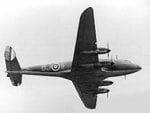 albatross-09.jpg64.1 KB · Views: 405
albatross-09.jpg64.1 KB · Views: 405 -
 albatross-14.jpg94.5 KB · Views: 412
albatross-14.jpg94.5 KB · Views: 412 -
 albatross-15.jpg107.7 KB · Views: 413
albatross-15.jpg107.7 KB · Views: 413 -
 dh-91 albatross-01.jpg102.3 KB · Views: 378
dh-91 albatross-01.jpg102.3 KB · Views: 378 -
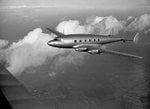 De Havilland albatross dec 1940.jpg79.8 KB · Views: 371
De Havilland albatross dec 1940.jpg79.8 KB · Views: 371 -
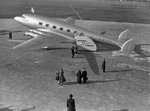 De Havilland DH91 Albatros 1938.jpg119.9 KB · Views: 427
De Havilland DH91 Albatros 1938.jpg119.9 KB · Views: 427
Last edited:
stug3
Staff Sergeant
Halifax

Nice stuff!
stug3
Staff Sergeant
The Albatross was a real beauty. I love the Hendon too though, it looks like something from a comic book.
Last edited:
stug3
Staff Sergeant
Halifax B Mark II Series 1, R9430 '19', of No. 1658 Heavy Conversion Unit based at Riccall, Yorkshire, being test-flown on the starboard inner engine only by Squadron Leader P Dobson in order to determine the height loss for emergency flights on one engine.

Lancaster B Mark I, W4113 'GP-J', of No. 1661 Heavy Conversion Unit based at Winthorpe, Nottinghamshire, in flight. W4113 was a veteran aircraft having flown on a number of raids with Nos. 49 and 156 Squadrons RAF in 1942 and 1943

Lancaster B Mark I, W4113 'GP-J', of No. 1661 Heavy Conversion Unit based at Winthorpe, Nottinghamshire, in flight. W4113 was a veteran aircraft having flown on a number of raids with Nos. 49 and 156 Squadrons RAF in 1942 and 1943
stug3
Staff Sergeant
stug3
Staff Sergeant
Flying Officer J F Greenam (in the centre) and his crew, photographed in front of Lancaster W4201 of No 57 Squadron at Scampton, February 1943. This image was part of a sequence taken for an Air Ministry picture story entitled 'T for Tommy Makes a Sortie', which portrayed the events surrounding a single Lancaster bomber and its crew during a typical operation.

Lancasters awaiting takeoff at Scampton.

Fraser Nash FN50 turret

Still from film shot in an Avro Lancaster by the RAF Film Production Unit, during a daylight attack on the Luftwaffe airfield and signals depot at St Cyr, France, by aircraft of No. 5 Group. A 4,000-lb HC bomb ('Cookie') and a smaller 500-lb MC bomb are seen just after they were released over the target.

Lancasters awaiting takeoff at Scampton.
Fraser Nash FN50 turret
Still from film shot in an Avro Lancaster by the RAF Film Production Unit, during a daylight attack on the Luftwaffe airfield and signals depot at St Cyr, France, by aircraft of No. 5 Group. A 4,000-lb HC bomb ('Cookie') and a smaller 500-lb MC bomb are seen just after they were released over the target.
Nice shots!
stug3
Staff Sergeant
Handley Page Halifax B Mark II Series 1A, HR952 'MH-X', of No. 51 Squadron RAF receiving a mixed load of 500-lb MC bombs and incendiaries in its dispersal at Snaith, Yorkshire, for a night raid on Germany.

A 4,000-lb GP Bomb is hoisted from its trolley during operational trials at Marham, Norfolk. It entered general service with Bomber Command squadrons in early 1943, but proved inferior to the 4,000-lb HC Bomb in its blast effect and was withdrawn from service by the end of the year. In the background Vickers Wellingtons of No. 115 Squadron.

A 4,000-lb GP Bomb is hoisted from its trolley during operational trials at Marham, Norfolk. It entered general service with Bomber Command squadrons in early 1943, but proved inferior to the 4,000-lb HC Bomb in its blast effect and was withdrawn from service by the end of the year. In the background Vickers Wellingtons of No. 115 Squadron.
stug3
Staff Sergeant
Annotated vertical taken during the major night raid on the Renault works at Boulogne-Billancourt, west of the centre of Paris. The largest number of aircraft sent to a single target so far - 235 - were despatched, dropping a record tonnage of bombs. A significant development was the mass use of flares to illuminate the target ('1' and '2'). Smoke and flame from exploding bombs can be seen on the factory ('3'), and also on the Ile St Germain ('4' and '5'). Only one aircraft, a Vickers Wellington, was lost during the raid, which was judged to be a great success.

A post raid image.

A post raid image.
stug3
Staff Sergeant
Armourers fit fuzes to 250-lb GP bombs on their trolleys, prior to loading into Handley Page Hampden Mark I, P1333 'EA-F', of No. 49 Squadron RAF at Scampton, Lincolnshire. P1333 crash-landed near Breda, Netherlands, on returning from a raid on Merseburg, Germany on 17 August 1940. By 1943 No 49 Squadron was equipped with Lancasters.

The bomb load most commonly used for area bombing raids (Bomber Command executive codeword 'Usual') in the bomb bay of an Avro Lancaster. 'Usual' consisted of a 4,000 impact-fused HC bomb ('cookie'), and 12 Small Bomb Containers (SBCs) each loaded with incendiaries, in this case, 236 x 4-lb incendiary sticks.

The bomb load most commonly used for area bombing raids (Bomber Command executive codeword 'Usual') in the bomb bay of an Avro Lancaster. 'Usual' consisted of a 4,000 impact-fused HC bomb ('cookie'), and 12 Small Bomb Containers (SBCs) each loaded with incendiaries, in this case, 236 x 4-lb incendiary sticks.
stug3
Staff Sergeant
Squadron Leader J D Nettleton of No. 44 Squadron RAF in one of the first operational Avro Lancasters. He is about to cross the western perimeter of RAF Waddington, Lincolnshire, with bomb doors open during a Squadron practice for low-level attacks in April 1942.

Armourers of No 149 Squadron at Mildenhall fit bomb carriers to a pair of 1,000-pounders, while behind Stirling 'N-Nuts' runs up its engines, 10 March 1942.

Armourers wait for the conclusion of an engine test on Short Stirling Mark I, 'OJ-N', of No. 149 Squadron RAF, parked at the end of the south-east runway at Mildenhall, Suffolk, before loading her with 250-lb GP bombs for a night raid on Essen, Germany. Each bomb has been fitted with a shackle to enable it to be winched into position in the Stirling's high bomb-bay.

Short Stirlings of No. 1651 HCU (Heavy Conversion Unit) in flight, 1942. W7427 'B' is in the middle of the formation.

Armourers of No 149 Squadron at Mildenhall fit bomb carriers to a pair of 1,000-pounders, while behind Stirling 'N-Nuts' runs up its engines, 10 March 1942.
Armourers wait for the conclusion of an engine test on Short Stirling Mark I, 'OJ-N', of No. 149 Squadron RAF, parked at the end of the south-east runway at Mildenhall, Suffolk, before loading her with 250-lb GP bombs for a night raid on Essen, Germany. Each bomb has been fitted with a shackle to enable it to be winched into position in the Stirling's high bomb-bay.
Short Stirlings of No. 1651 HCU (Heavy Conversion Unit) in flight, 1942. W7427 'B' is in the middle of the formation.
Attachments
Last edited:
Users who are viewing this thread
Total: 1 (members: 0, guests: 1)

